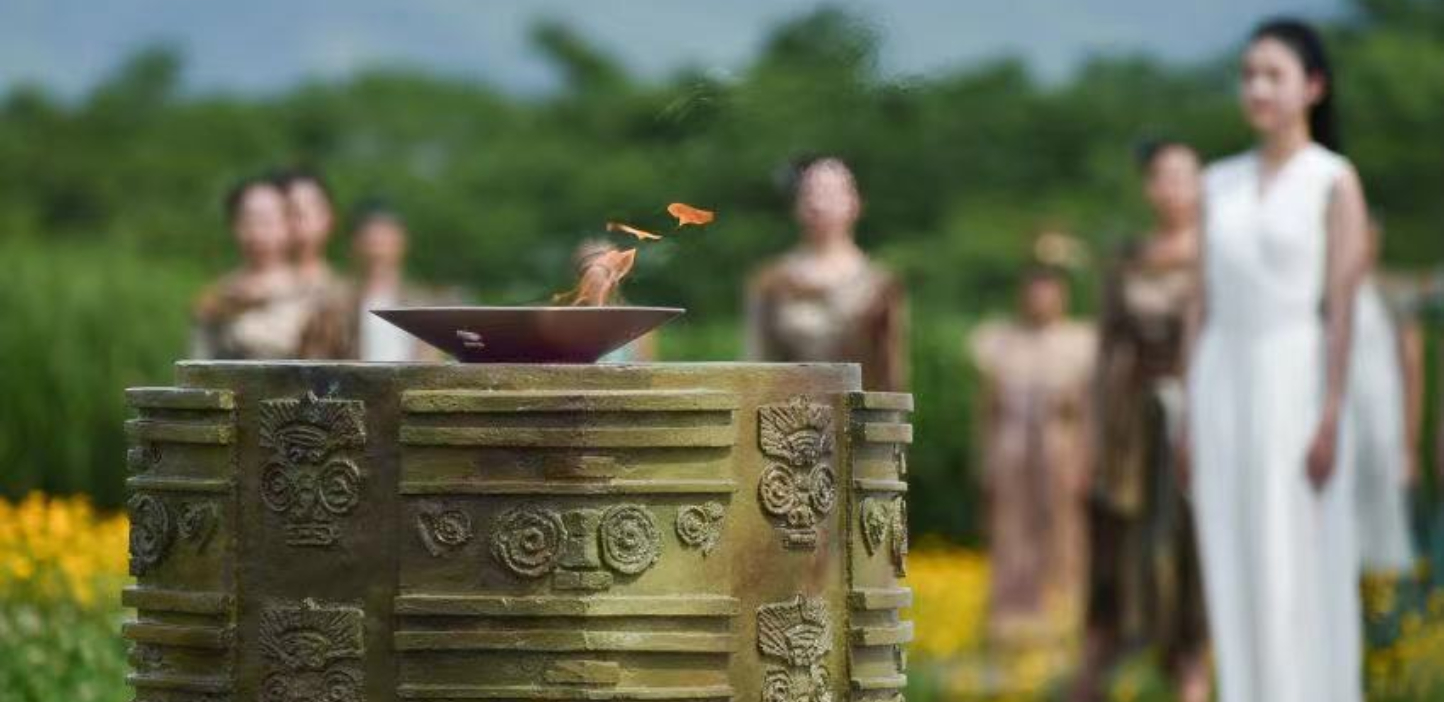亞運會的火種在杭州余杭區的良渚古城遺址公園大莫角山採集。杭州亞運傳遞的火炬「薪火」,融合傳統文化和當代藝術,設計師說設計理念源自良渚文化。甚至本屆亞運會的獎牌的設計靈感都離不開良渚文化的內容。
為何良渚古文化在本屆亞運中,被重點採用及推崇呢? 主要原因是在杭州的良渚古城遺址是人類早期城市文明的典範,遺跡和遺物的出土證實了中華文明五千多年的歷史。2019年,聯合國教科文組織將良渚古城遺址列入「世界遺產名錄」。透過本屆杭州亞運會不同的場合及媒介,向世界展示中國的文化,開啟一場古今穿梭的自然人文之旅。
良渚古城遺址內出土數以千計精美的玉器,玉琮、玉鉞、玉璧等,本屆的火炬就採用了很多古玉器的元素。首次採用了「方形桶身」的設計,上方下圓,頂部出火口的形狀源自「琮」字最早的甲骨文字形。炬冠呈方形的設計,靈感也源自玉琮形態,炬身以良渚螺旋紋為演化。紋樣形似指紋,精緻細密,炬基則以代表浙江八大水系的八組水波紋為裝飾,並以中國結穗收尾,寓意各國運動員團結共融。
運動員能夠站在台上領獎牌是最大的榮譽,杭州亞運獎牌名為「湖山」,創作靈感也源自良渚文明,結合杭州的江南文化。獎牌正面用線條勾勒出「三面雲山一面城」的圖像,呈現杭州的山水風貌,外觀是將方形玉琮和圓形獎章融為一體,蘊含中國文化的「方圓」之道。獎牌背面形似方形印章,寓意運動員們在杭州亞運會上留下美好的印記。出土的文物證明了良渚文明比夏、商、周王朝還要早,對夏商周文明乃至後世影響深遠;比如良渚遺址出土的玉器,正是夏商周時期禮器的形制。良渚文明與亞運盛典相結合,古今匯聚是表達世界各種古老文明中,唯有中華文明從未中斷,上下五千年,一直發展至今。
The flame of the Hangzhou Asian Games was lit in the park of the Archaeological Ruins of Liangzhu City on June 15.
"Eternal Flame", which is the torch of the Games, was designed by blending the traditional culture and modern arts, and the designer said proudly that the design was inspired by the Liangzhu culture.
And the design of the medals was also inspired by the rich and splendid Liangzhu culture.
Why the elements of the ancient Liangzhu culture play such an important role in the Hangzhou Games?
The reason is simple: the Archaeological Ruins of Liangzhu City in Hangzhou is an example of the early urban civilization of mankind, and the relics unearthed are testament to the 5,000-year-old Chinese civilization.
In 2019, the Archaeological Ruins of Liangzhu City was inscribed as a UNESCO World Heritage Site.
And the Games will, via different platforms and mediums, showcase the Chinese culture to the world, and open a journey for all to experience the nature and culture of China, traversing from the ancient times to the contemporary.
Exquisite jade wares, such as jade cong (square-shaped jade), jade yue (axe-shaped jade) and jade bi (disk-shaped jade) were unearthed from the archaeological ruins site of the ancient Liangzhu City, and the designer of the torch of the Hangzhou Games also borrowed elements of ancient jade wares.
The torch was designed to be square-shaped at the top and round-shaped at the bottom, with the burner nozzle shaped like the earliest script Cong from the oracle bones.
The torch head is designed to be square-shaped, and the design was inspired by the shape of jade Cong, and the torch body is decorated with delicate and exquisite dermatoglyphic fingerprint patterns.
The torch base is embossed with eight water veins representing the eight major river systems in Zhejiang. The dermatoglyphic pattern ends with Chinese knot tassels to demonstrate the unity of athletes involved in the Asian Games, with good wishes to build a community with shared future for mankind.
The medal for the Hangzhou Asian Games is named “Shan Shui”. The design concept was also inspired by the Liangzhu culture as well the Jiangnan culture in Hangzhou.
The front side of the medal is characterized by the 3 sides of the landscape of misty hills, representing the geographical landscape of Hangzhou.
It seamlessly integrates the squared-shaped jade Cong and the round-shaped medal, embodying the square-round harmony in the Chinese culture.
The back side is shaped like a square seal, implying that the athletes will have beautiful memories of the Hangzhou Asian Games.
The unearthed relics stand as proof that the Liangzhu culture was much earlier than the Xia, Shang and Zhou dynasties, and had far-reaching significant influence on the ensuing dynasties.
For example, jade wares unearthed from the archaeological site of the Liangzhu City were exactly in the shapes of ceremonial and sacrificial wares of the Xia, Shang and Zhou dynasties.
The perfect integration of the Liangzhu culture with the grand Asian Games is to show that among all ancient civilizations The Hanghou Asian Games to showcase Chinese culture to the worldacross the world, the Chinese civilization is the only one that has lasted non-interrupted for more than 5,000 years, and is still robust and developing.

